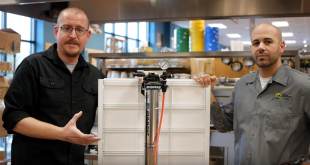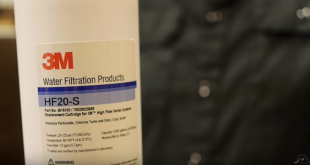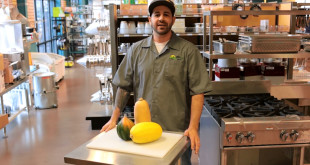Trying to figure out if your knives need to be honed or sharpened? In our upcoming video series, we’ll show you exactly what you need to know to keep your favorite kitchen tools sharp. Our first few videos we’ll cover knife care and maintenance, then move into what different knives are used for cutting different foods. With that, we say without further ado, here’s our first video on how to hone a knife.
Video Transcribe
Chris Tavano: Hello! Welcome to Tundra Restaurant Supply. I’m Chris Tavano, and I’m going to be taking you through some knife care and maintenance today. Today we’re going to be talking about the differences between honing and sharpening; and the different kinds of stones for sharpening, as well a,s the different kinds of steels and rods for honing.
When you’re honing, we got to think about what’s going on with the blade itself. When you have a nice sharp blade, it should look like this. Nice and even on both sides. Then there is a bevel. That is what we call this angle that’s going to the tip.
What happens as you use your knife and it wears down, that beveled tip starts to turn a little bit more blunt and starts to be a little more rectangular. Also, what can happen is that tip will create burrs. You tend to see a lot more metal fragments and inconsistencies or jagged edges on the knife edge itself.
What honing is going to do is remove those burrs and shape your blunt edge back into a nice beveled tip. However, the difference with sharpening now is when those burrs and jagged edges get too large as well as your blunt edge too big to where you can’t cut through a tomato or a lemon or an onion. That’s when you’re actually going to want to sharpen your knife and grind it down to a whole new blade creating a new beveled edge.
Now we’re going get into details of honing your knife and what honing rods are. Right here, we have a typical honing rod, which is a round shape. They come in many different shapes. Again, this one is another honing rod with an oval shape. There are also honing rods that are round, comes with a helical cut. What that means is the grip on the rod itself is in a spiral fashion to give it more abrasiveness.
Also keep in mind, honing rods are made of different materials. This one, for instance, stainless steel much more abrasive than the knife so that way it can … much more abrasive and harder than the knife. That way it can actually shape the blade itself.
This one, this oval one, is actually diamond-plated. Anything that involves diamond is also going to do a little bit of sharpening, but you’re not quite sharpening as if you would with a stone itself. Again, these are called honing rods. They’re first purpose is honing your blade. Again, if you have a diamond in it, it does a little bit o sharpening, but don’t count on it.
How do you distinguish what kind of sharpness your blade has, and does it need honing or sharpening? Great way is a tomato. Somewhat overused. It gets a little cut up at the first beginning bite through the skin of the tomato. This blade, if you think about it, is still fairly sharp. We could use a typical honing steel rod. Again, then if your blade is slightly dull, you’re going want it, you can also use a diamond rod. That way you can get a little bit of sharpness on and grinding on your blade. Then if your blade is totally blunt and you can’t even get through the skin of the tomato, you’re going to want to sharpen your blade all the way.
We’re using a steel round honing rod. Then you’re going to want to think about an angle on German knives. Typically the angle of the bevel to the blade is about 20 to 22 degrees. Then on Japanese knives, the blades are little bit thinner, but they’re also a little bit stronger. Those angles go to about 12 to 15 degree.
Again, we’re using a German blade so we’re just going to go for a rough 20 to 22 cut. Best way to do that is put your blade parallel with the rod itself. That’s 90 degrees, and you’re going to think 45. Then bring it back to the half of the 45. That’s roughly 22 ½. From there, you want to think about a nice consistent stroke. The stroke you want to take is from the top of the rod to the bottom of the rod, but simultaneously on the bias from the heel of your blade to the tip of the blade, all in one simultaneous motion. Then rotate on the next side. Keep rotating back and forth, left and right, until you made a significant amount of passes, probably about 12.
Now that we have a nice reshaped blade from honing our knives, we can see that this will get to the tomato a little bit better. Keep in mind, if honing did not quite do the job that you were looking for and you’re still having difficulties cutting through your tomatoes and onions, you might want to think about trying to sharpen it with a sharpening stone.
Last but not least are little bit more of the handheld honing devices themselves. I tend to think this is a little bit more dangerous, but that’s all up to you. Mostly, this one that is handheld because you’re actually preening the blade towards your fingers. This is a very nice one. It comes with two grips as well, a fine and a coarse. Again, same thing applies. You’re going to want to put your blade in there, keep a nice, firm pressure, and make a consistent stroke all the way back. The nice thing about this one is it has the angled pre-determined for you.
They also make this version in electric as well. That way, you don’t have to do much work yourself especially if you need a lot of work done to your blade. Also keep in mind, these two devices were really made for honing. Unless they have a diamond steel within them, like we mentioned earlier, it does do a little bit of sharpening, but, again, these are designed for honing. The real sharpeners out there are stone and grinders.
Again, I’m Chris Tavano and this is Tundra Restaurant Supply with knife honing and maintenance.
Before taking action from the content or resources published here, we request that you visit and review our terms of use.
 Corner Booth Blog | TundraFMP Restaurant Supply, News & Equipment Blog
Corner Booth Blog | TundraFMP Restaurant Supply, News & Equipment Blog



